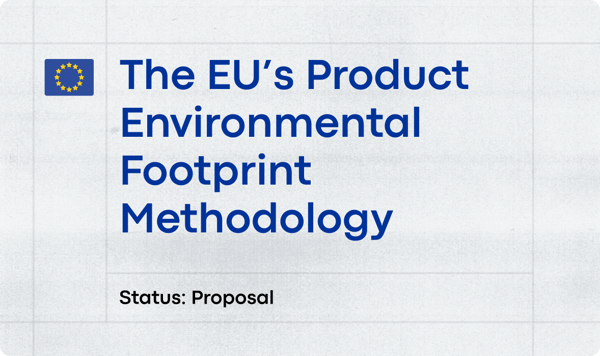In today's rapidly evolving environmental reporting landscape, accurate data for tracking carbon emissions is more crucial than ever. For apparel and footwear brands aiming to track carbon emissions, set science-based targets (SBTi), and comply with regulatory standards like the CSRD, establishing a baseline year is necessary.
A baseline refers to the starting point against which a company measures its greenhouse gas (GHG) emissions reductions. This typically represents the company's emissions at a certain point in time, often the most recent year for which comprehensive data is available. By comparing future emissions to this baseline, a company can see if it is successfully reducing its carbon footprint over time (or if it’s increasing).
Many sustainability managers we work with are concerned that making changes in the way they measure emissions - such as implementing carbon management software, switching consultants, or employing improved methodologies such as switching from a spend-based to an activity-based calculation approach - might reveal a larger company footprint, requiring them to adjust their baseline. Brands often stress over the potential shift in emission factors and the impact this change might have on their previously communicated data. Even more often, the question arises: how will we explain this in our environmental report?
This article aims to guide apparel and footwear brands through the re-baselining process, essential for maintaining the relevance and accuracy of sustainability metrics as more accurate data becomes available. We will explore examples, including H&M’s approach, and provide insights on how to communicate uncertainties and changes in methodologies in environmental reports.
When to “re-baseline”: SBTi use case
The Science-Based Targets initiative (SBTi) guides global efforts against climate change, aligning with the Paris Agreement's goal to limit temperature rise to 1.5 degrees. Especially in industries like apparel and footwear, where greenhouse gas emissions are significant, setting science-based targets (SBTs) helps companies proactively address their environmental impact, aligning their operations with global climate goals and contributing to a sustainable future.
According to the SBTi guidelines, re-baselining is necessary when significant changes occur that could impact the relevance and consistency of existing targets. Companies should re-baseline when:
- Scope 3 emissions become 40 percent or more of aggregated scopes 1, 2, and 3 emissions.
- Emissions exclusions in the inventory or target boundary change significantly.
- Significant changes in company structure and activities (e.g., acquisitions, divestitures, mergers, insourcing or outsourcing, shifts in goods or service offerings).
- Adjustments to the base-year inventory or changes in data used to set targets, such as growth projections, occur (e.g., discovery of significant errors or a number of cumulative errors that are collectively significant).
- Other significant changes to projections or assumptions used in setting the science-based targets.
The SBTi recommends recalculating targets if there is a 5% or greater change in an organization's total base year emissions or in the emissions covered within a target boundary. This is a great example of how to ensure that the targets reflect the most accurate and current data, maintaining their scientific validity.
Why do fashion brands fear re-baselining?
The idea of re-calculating your base year's carbon emissions introduces a set of uncertainties:
Discovery of Increased Emissions
Base year recalculation might expose previously underestimated emissions due to improved methodologies or more thorough data collection. Such findings can seem like a setback for brands that focus on reducing their environmental impact.
Adverse Impact on Targets
Updating the baseline can make it appear that a company is further away from its emission reduction targets. This can affect how stakeholders, including investors, perceive the brand's commitment and progress towards sustainability goals.
Reporting and Compliance Complications
Adjusting the baseline necessitates changes in emission reporting and can complicate compliance with environmental regulations. The process requires significant resources to manage additional documentation and explanations, which can be a burden.
Financial and Operational Implications
A new baseline might require more aggressive carbon reduction strategies, potentially leading to increased operational costs. These changes can impact a company’s financial strategy and its commitment to long-term sustainability initiatives.
Why should you “re-baseline” anyway?
Environmental metrics are inherently dynamic. As brands collect more primary data and their understanding of carbon footprints and environmental impacts deepens, the baseline should be adjusted to reflect the most current and accurate information. This ensures that targets remain scientifically valid and progress reports are transparent and reliable.
Failing to re-baseline carbon emissions when necessary can lead to significant consequences for brands, including regulatory non-compliance, which may result in legal penalties and fines. It can also jeopardize certifications with standards like the Science Based Targets initiative (SBTi), affecting credibility with investors, shareholders, and customers.
Therefore, each year, as new data and improved methods become available, brands should integrate these updates systematically. This approach, which we term "using the same lens to compare historical data," ensures that tracking and reporting are consistent and comparable over time. To provide a clear and accurate view of your environmental impact, brands maintain the integrity of historical data by applying updated methodologies retrospectively. This allows brands to present a true and fair view of progress and ensures that our targets remain aligned with the latest scientific insights.
The principle is straightforward: the most recent version is always the most accurate. Therefore, when communicating with investors and external stakeholders today, it's essential to relay the current version of data. While this may differ from the static nature of financial reports, it reflects the dynamic nature of environmental measurement.
What is Carbonfact's approach?
At Carbonfact we believe that accurate data is a crucial foundation for decarbonization. Therefore we regularly update and improve our LCA engine and methodology based on the most recent available data and science.
When changes occur, Carbonfact automatically recomputes all historical emission factors; this ensures that your environmental footprint data remains accurate and up to date according to the latest science.
Sometimes the brands we work with are worried about their emission data changing when we improve our LCA model or we integrate more of their primary data, as it might require them to re-baseline.
In the Carbonfact platform, you can always see exactly when and why the data changed, and you can directly include this reasoning as a reference in your reporting. Carbonfact’s changelog feature allows you to keep track of your platform's progress. Our version control ensures that when we add more primary data or enhance our LCA engine, a new version is released. You can easily access the change history to view the number of products received, completed, and measured, and the average carbon footprint of your catalog at the time of release. This ensures a comprehensive audit trail, including data input change logs, and calculation formulas.
As we gather more precise data and refine our methodology, the variations in average carbon footprints will diminish over time. This continuous improvement ensures that our environmental reporting becomes more reliable and robust as we progress.
.png?width=2880&height=1800&name=Versions%20Home%20(1).png)
Carbonfact's Changelog feature
Examples: Communicating data changes in the environmental report
Brands often worry about how to communicate changes in their carbon footprint within their environmental reports. Let’s take a look at a couple of sustainability report examples to see possible ways of communicating changing methodologies and footprints.
H&M: Applying changes to historical results
In its sustainability report, H&M details its calculation methods and data. It emphasizes maintaining historical integrity in its results, ensuring that changes in methodology do not compromise the accuracy and consistency of its data over time.
Each year, H&M updates its methodologies to incorporate the latest data and improved practices. These updates are reflected in its sustainability reports, allowing for accurate and reliable comparisons over time. By consistently applying the most current methodologies, H&M ensures that its environmental impact assessments are both precise and reflective of its ongoing efforts to reduce emissions.

Source: H&M Sustainability Disclosure 2023
Hultafors Group: Adjusting base year emissions
In a significant move towards more precise carbon management, Snickers Workwear, part of the Hultafors Group, began collaborating with Carbonfact at the end of 2023. Here is an example of how the brand communicates the upcoming changes in methodology and base year:

Source: Hultafors Group Sustainability Report 2023
About Carbonfact
Carbonfact is a sustainability platform for apparel and footwear brands, enabling them to measure, report, and reduce their environmental footprint with the least manual effort.
See our platform in action:







-1.jpg) Laurent Vandepaer, PhD
Laurent Vandepaer, PhD

 Lidia Lüttin
Lidia Lüttin
